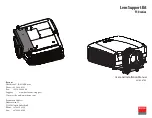
other damage to the vehicle’s finish caused by im-
proper use of the magnetic tow lights are not covered
under warranty.
4.
If there is excess electrical cord, wrap the slack around
the driver’s side light, as shown in Figure 2.
5.
Position the two lights (Figure 2) over the points you
have chosen.
Note: the driver’s side light has two electrical cords
extending from the base; the passenger’s side light has
only one (Figure 2).
Position the driver’s side and passenger’s side
lights as described above, and as shown in Figure 2. If
the lights are reversed, the towed vehicle’s turn signals
will be reversed, which may cause an accident.
Failure to follow these instructions may cause prop-
erty damage, personal injury or even death.
6.
Each time before towing, test the system for proper
function, as described in step five under “Connecting the
wiring.”
7.
The weather cover over the female four-prong con-
nector at the towing vehicle will prevent damage from road
debris or corrosion. Keep the female four-prong connector
covered when not in use.
Figure 2
continued from preceding page
connector) at the back of the towing vehicle, close to the
center.
The four-prong connector must be attached at the
rear of the towing vehicle, close to the center. Attaching
the connector toward either side of the towing vehicle
may cause the wiring to be pulled loose, or to drag on
the ground, when the towing vehicle turns.
5.
Test the system: follow the steps below to attach the
lights to the rear of the towed vehicle. With the towing
vehicle’s engine on (or the ignition key in the ‘on’ posi-
tion), turn on the headlights. Now, press and release the
brake pedal and activate the turn signals to verify that the
magnetic lights work in tandem with the towing vehicle’s
turn signals and brake lights.
Attaching the lights…
1.
The magnetic tow lights are attached to a length of
electrical cord with a male four-prong connector. Plug
this connector into the female connector at the end of the
three-foot wiring harness.
2.
Route the electrical cord and the magnetic lights to the
back of the towed vehicle.
Position the electrical cord so that it will not rub
against the towed vehicle’s finish. The finish may be
damaged if the cord rubs against it during towing.
Keep the cord away from all moving parts. Severe
damage to both vehicles, as well as the components
of the towing system and the magnetic lights, can oc-
cur if the cord becomes entangled in the wheels, the
tow bar or hitch, or any other moving component.
The wiring can be damaged if the electrical cord
is pinched or crushed. If the wiring is damaged, the
magnetic lights will not operate.
Damaged wiring may also cause a short circuit,
which can blow a fuse in the towing vehicle, as well
as cause other, consequential damage to the towing
vehicle’s electrical system or other components.
Failure to follow these instructions may cause prop-
erty damage, personal injury or even death.
3.
Choose an area on the rear of the towed vehicle to
position the two magnetic lights, so that they will be clearly
visible to drivers behind the towed vehicle.
To reduce the likelihood of scratches or other dam-
age to the towed vehicle’s finish, make certain that
both the underside of the magnets and the surface of
the towed vehicle are clean.
Also, do not drag the magnets across the surface
of the towed vehicle.
Failure to follow these instructions will damage
the towed vehicle’s finish. Scratches, paint chips and
Learn more about other trailer hitches & towing products on our website.




















